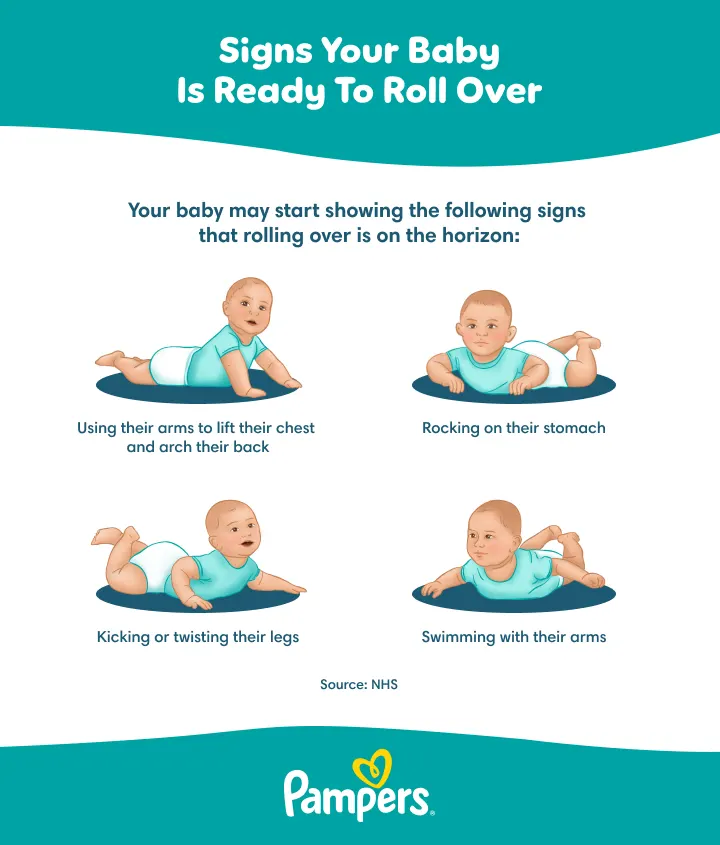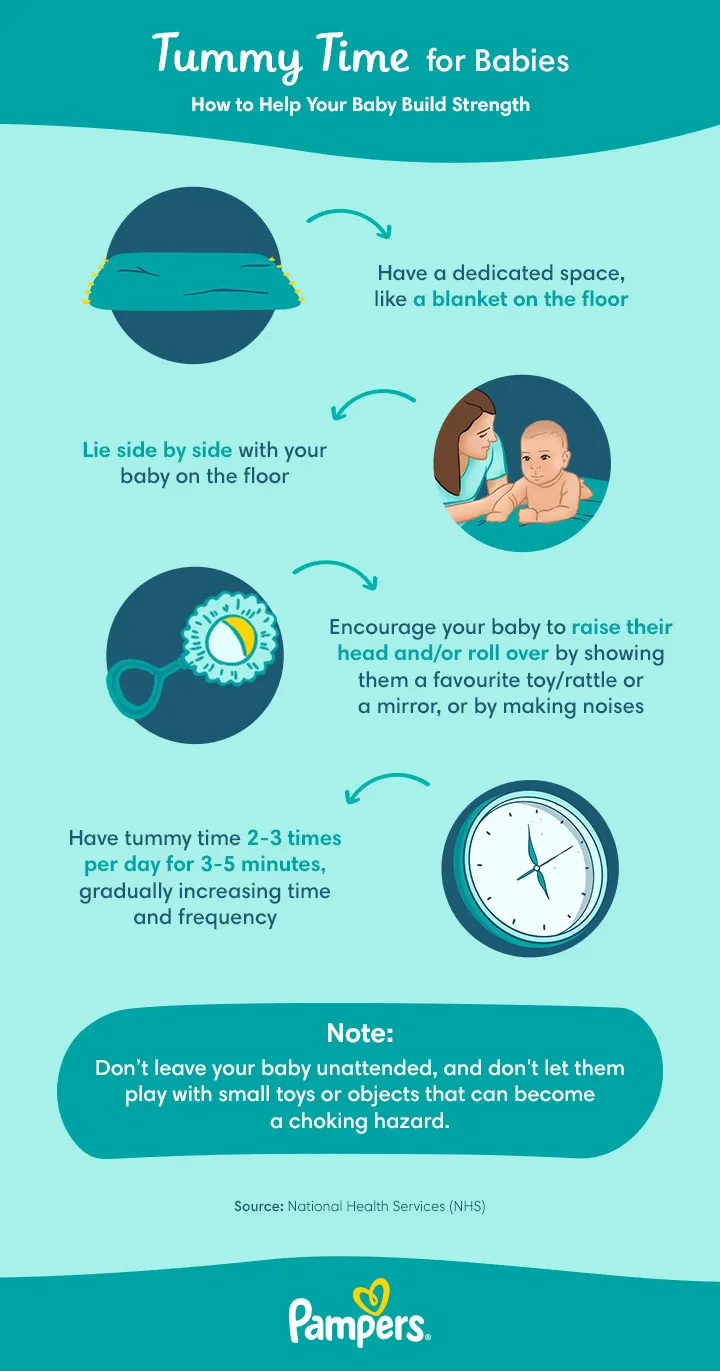
When Do Babies Roll Over and How to Encourage It
5 min readUpdated October 17, 2025
5 min readUpdated October 17, 2025
Wondering, 'When do infants roll over'? Around four to seven months is when most babies begin to roll over, though a few may start as early as three months. The milestone usually progresses first with a tummy-to-back roll, with the back-to-tummy move coming a few weeks later. Watch for signs that your little one is getting ready to roll: stronger neck and arm muscles, longer time spent on the tummy, and growing curiosity about the world around them.
Here’s a quick overview of typical rolling milestones:
If your baby is not rolling over by 6 or 7 months or you have any concerns, it’s best to talk to your GP or health visitor. This guide looks at ways to support your baby’s development and promote safe rolling. Remember that every baby develops at their own pace, and milestones arrive at different times.
When Do Babies Start Rolling Over? Key Developmental Stages to Look For
You may be wondering, 'When do newborns roll over'? or 'What age do babies roll over'? Rolling over usually occurs between four and seven months. However, every baby is unique and may reach this milestone at a different time, as their development progresses at its own pace.
The rolling over milestone starts with a few noticeable signs of development. At around five months old to about 7 months, your baby may start to show the following signs that rolling over is on the horizon:
Developing these kinds of gross motor skills is necessary for your baby to be able to roll over eventually.
Your baby’s rolling adventure has begun! From first rolls to first steps – watch how your little one grows each month.
When Do Infants Roll from Tummy to Back?
There's no set timetable for when babies start rolling over, as development varies from child to child. For many, the first milestone is baby rolling from tummy to back, usually around four to five months.
When Do Infants Roll from Back to Stomach?
Just like rolling from belly to back, you can’t predict the exact age at which your baby will do this. However, it’s common for babies to roll over in both directions by around seven months.
How to Encourage Your Baby to Roll Over: Tips and Techniques
Babies learn through play and exploration, so what feels like a teaching moment to you will feel like a fun game to them. Take this as an opportunity to foster their physical development.
To answer how to teach your baby to roll from tummy to back, or back to tummy, tummy time is a key starting point!
Tummy time is an activity you can start from birth with short, supervised sessions. Encourage rolling over by placing your baby on their tummy for brief periods while awake, with you close at hand. Eventually, you may start seeing your baby rolling over from tummy to back.
Here are some tips for encouraging rolling over:
How to Keep Your Baby Safe When They’re Rolling Over
As your baby grows and develops new skills, supervise them closely, especially around elevated surfaces like changing tables, beds, and sofas. Always keep one hand on them to prevent falls.
There's never been a better time to baby-proof your home, especially as your little one begins to explore. If you haven't done so yet, consider fitting a stair gate and securing furniture that could topple.
Even if your baby is rolling over, be sure to put them on their back when placing them in a cot or bassinet.
What to Do If Your Baby Isn’t Rolling Over: Warning Signs & Next Steps
If you're wondering when do babies roll over because you're concerned about their development, you'll find that your little one may reach certain milestones sooner than others, or they may take a little longer to master certain skills. This is normal! Every baby is an individual and develops at their own pace.
Your baby’s GP or health visitor will track their growth and development. If you’re concerned your baby hasn’t rolled over yet, or you’re worried that your baby not rolling over at 7 months isn’t following the expected pattern, or you have any other concerns about your baby’s development, talk to your GP or health visitor at your next appointment.
How Tummy Time Helps Babies Build Muscle for Rolling Over
As mentioned above, tummy time plays a vital role in helping babies develop the muscles necessary for rolling over, and the benefits of tummy time highlight its importance for lifelong movement. By spending time on their stomachs while awake, babies strengthen their neck, shoulders, arms and core muscles, which are all crucial for rolling.
So, what age do you start tummy time? Experts recommend starting tummy time from birth with short, supervised sessions to gradually build strength. This positioning encourages babies to lift their heads and push up, building the muscle coordination they need for milestones like rolling over.
Other Developmental Milestones to Spot
Seeing your baby reach the 'rolling over' milestone is an exciting moment. Throughout your little one’s infancy, you’ll watch many skills develop as they reach various milestones. Here are some physical developmental milestones you’ll likely see in your baby’s first year or two:
Just remember that all babies develop in their own unique way. So, some might even skip a milestone altogether and move on to the next. Or some babies might need a little more time with one milestone, then blast through the next one. You can always mention any questions or concerns at your next health visitor visit, as they’re a good source of support and information related to your little one’s growth and development.
FAQS AT A GLANCE
For most babies, rolling over doesn’t start until about four months old. That said, every baby is different, and for some, this milestone may come a little sooner.
If you’d like guidance on your baby’s development, speak to your GP or health visitor.
The Bottom Line
Your baby’s first years are an exciting journey of growth and development. With plenty of supervised tummy time, they’ll build and strengthen the muscles and coordination they’ll need to start rolling over. After that, they’ll continue building up their movement, eventually sitting up, crawling and walking, all within their own timeline.
Answering the question, ‘When do babies start to roll over? ’ requires an age range, as rolling over is a developmental milestone that can happen as early as 4 months or around 6 or 7 months or even later. If your little one needs more time to master this skill, that’s OK, too, especially if they were born early, before 37 weeks. Be sure to connect with your health visitor with any questions or concerns as they track your baby’s growth and development.
Whether your baby is loving tummy time or starting to show signs of wriggling and rolling, they’ll be on-the-go soon enough! Time flies, so enjoy these precious moments and milestones as they come. One thing all babies need at every age, however, is nappies. To earn cash for all your Pampers nappies and wipes purchases, download the Pampers Club app today!
How We Wrote This Article
The information in this article is based on expert advice found in trusted medical and government sources, such as the National Health Service (NHS). You can find a full list of sources used for this article below. The content on this page should not replace professional medical advice. Always consult medical professionals for full diagnosis and treatment.
- Berkshire Health Care NHS. “The Early Years Toolkit.”
- National Health Services (NHS). “Baby and Toddler Safety.”
- National Health Services (NHS). “How to Keep Your Baby or Toddler Active.”
- National Health Services (NHS). “Reduce the Risk of Sudden Infant Death Syndrome (SIDS).”
- NHS Inform Scotland. “Your Baby’s Development From 2 to 12 Months.”
- NHS Oxford Health. “Gross Motor Skills (Babies and Toddlers).”
- Parentclub. Scot. "When Will my Baby Roll Over?"
Read more about Newborn Baby
Join Pampers Club and get:






